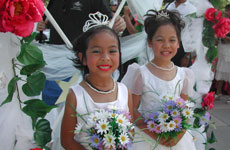Human Flower Project
Flower Pot Holes
Here’s a fine Yankee take on Gandhigiri – the practice of meeting conflict with flowers.
After a beaver dam broke near Mill Creek Road in Orrington, Maine, the county sent in heavy equipment to tear up pavement in preparation for repairs. Mill Creek Road was due for resurfacing too and as long as the equipment was in the vicinity, the county authorities opted to have it torn up also. So residents along the lane have been dodging major potholes since March.
Recently, someone found a beautiful way to draw attention to the damaged road, meanwhile pointing out the biggest potholes for drivers. They planted flowers in the chunk-holes.
“I think it’s awesome,” said Jesse Schwarcz, whose parents, Mary Ann and Arthur, live on the road. “It gets so tiring to drive through those potholes and hit the bottom of every single one and swerve all the biggest ones. If they’re not going to grade the road and keep it maintained, then we can at least enjoy the flowers.”
Thanks to Alex Barber of the Bangor Daily News for the report.
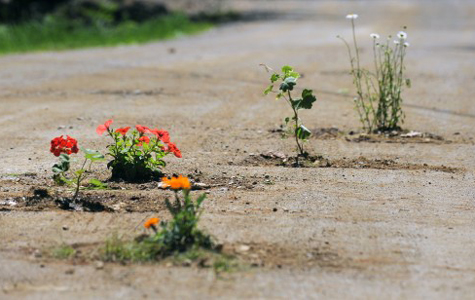
Potholes on Mill Creek Road in Orrington, Maine, have been planted with flowers by an anonymous garden enthusiast.
Photo: Gabor Degre, Bangor Daily News
Permalink
Planting the Flag
To honor local Marine Jean Villanueva, the Murrieta, California, Fire Department planted an American flag flower bed in his family’s yard, just in time for Villanueva’s homecoming from Afghanistan.
Todd Bradstreet of the Murrieta FD initiated Project Greenthumb to help with yard work at the homes of residents with family members away in military service. Villanueva’s wife, Jodie, signed up for the program and got lots more than she was expecting: lawn mowing, some landscaping, and then this patriotic raised garden with “stripes” of red and white petunias.

Marine Cpl. Jean Villanueva,wife Jodie, and their daughter Leilah, enjoy sit in the yard that Project Greenthumb tended in Villanueva’s absence.
Photo: Bill Wechter
Permalink
Topped with Flowers of Ash
The National Endowment for the Arts has named basketmaker Molly Neptune Parker among this year’s National Heritage Fellows, a program modeled on Japan’s longstanding recognition of “National Treasures.” We were especially drawn to Parker’s “flower” topped baskets, a design she learned from her mother and grandmother, traditional Passamquoddy basketmakers all. But like all great folkartsts Molly Neptune Parker has pushed forward the Native American tradition in which she was raised, the better to honor a legacy.
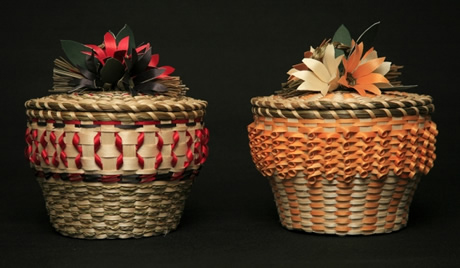
Two of Molly Neptune Parker’s baskets, topped with “flowers” made of ash splints.
Photo: National Endowment for the Arts
Permalink
Bees Lead
A new study by a group of scientists working in Australia has concluded that in the co-evolution of bees and flowers, bees—not flowers—lead the way. Basing their work on earlier research that theorized Australia’s first flowers were relatively colorless, the scientists then examined the color spectrum most easily perceived by honeybees and bumblebees. The native flowers examined tended to be of colors that bees find easiest to detect.
“We collected spectral data from 111 Australian native flowers and tested signal appearance considering the colour discrimination capabilities of potentially important pollinators.” Their findings regarding color were consistent with those reached in North American studies. “Subsequent mapping of Australian flower reflectances into a bee colour space reveals a very similar distribution of flower colour evolution to the Northern Hemisphere. Thus, flowering plants in Australia are likely to have independently evolved spectral signals that maximize colour discrimination by” bee pollinators.
Bees, by the way, “have trichromatic colour vision based on ultraviolet- (UV), blue- and green-sensitive photoreceptors.” Their “best discrimination” is for blue wavelengths (close to 400 and 500 nm). The scientists write, “behavioural experiments on free-flying honeybees have confirmed this theory.”
You can find the complete paper here.

How bee vision would see a flower, one that looks yellow to human eyes
Photo: Phys
Permalink
The World’s Slickest Vase
With the Stanley Cup playoffs underway, we went looking for a floral tie-in. Not too many goalies with corsages out there. But we did find this photo of Brad May, the “lucky Duck” who represented the Anaheim team in the Tournament of Roses parade 2008, after the Ducks’ 2007 Stanley Cup victory.
According to this source, 2007 was the first year a California team won ice hockey’s mega trophy.
We’re rooting for the New Jersey Devils this year, but send this memo out to both teams. The Stanley Cup would make one helluva flower vase: Win it and fill that top bowl up with some heliconia. (You’ll need a sturdy frog.)
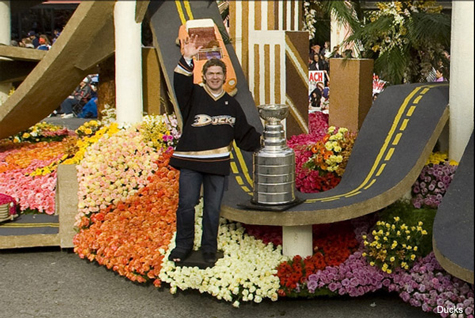
Former Anaheim Duck ice hockey player Brad May and the Stanley Cup rode Anaheim’s city float in 2008’s Tournament of Roses Parade.
Photo: via puckdaddy
Permalink
Carnations Away!
Repurposing a bomber plane?
Great idea. All you pacific and visionary generals, look to the skies of Palm Springs, California. There for the 14th year in a row, a B-25 bomber dropped carnations in honor of fallen veterans this Memorial Day.
Three Beechcraft T-34s scored the sky in the “Missing Man” formation and then the B-25 opened up, releasing 3000 red and white flowers over the Palm Springs Air Museum.

Memorial Day flower drop 2006 at the Palm Springs Air Museum
Photo: Hanna Scholla
Permalink
A Haven in New Haven

Marsh Botanic Gardens, designed by Beatrix Jones Farrand
Photo: Georgia Silvera Seamans
My 2001 class photo was taken in the backyard of Marsh Hall on the Yale School of Forestry and Environmental Studies campus. As a student I did not spend much time at Marsh; most of my courses were held in Sage Hall. It was not until I read a 2012 Yale Alumni Magazine essay that I realized the garden behind Marsh was more than a backyard; it was the Marsh Botanic Gardens.
Furthermore, it was designed by Beatrix Jones Farrand, a preeminent woman landscape architect of the 20th century and, indirectly, a personal patron. Farrand left an endowment for the College of Environmental Design at UC Berkeley which funded part of my dissertation research.
According to the Gardens’ official website: “Our modest outdoor displays include remnants of the original design by Beatrix Farrand, whose relationship with Yale University began in 1923 and lasted for decades. The display areas also include naturalistic plantings on the hillsides using American native wildflowers, grasses and woody plants. The perennial and annual beds near the greenhouses provide spring, summer and fall color…. Her design was implemented over several years, and included a formal garden, patterned after the earliest existing formal garden, in Padua, Italy. Her design also included a rock garden, which is the last and best remnant of her work at Marsh.”

“Naturalistic hillside” at Marsh Botanic Gardens, Spring 2012
Photo: Georgia Silvera Seamans
I chose to photograph not this “last and best” but the “naturalistic plantings on the hillsides” – what does this say about my landscape aesthetic?!
You can read more about Beatrix Jones Farrand here and here.
Permalink
Flower Seed Factory
One more indication of how things – including human-flower culture – have changed in the past century: Hide the factory!
How many products today are marketed with images of the factory or industrial work behind them? We can’t think of one. There might be a nice portrait of one worker at a sewing machine or on an assembly line (smiling, of course) but nothing that demonstrates how the multiple gears of industrial manufacturing work or the interlocking tasks of people within that system. Our contemporary culture of the expressive individual would be bored, confused—even repulsed.
Not in the late 19th century. At least William Henry Maule didn’t think so. Here’s the cover of his 1892 seed catalogue with a fascinating schematic drawing of his Philadelphia seed company’s inner workings. Human figures are antlike, rolling barrels and dollies, packing seed, shuffling items through the mailroom.
The catalogue is one of many in the
“ title=” smithsonian institution’s collection”>Smithsonian Institution’s collection. For a bigger version, click here.

Cover of seed catalogue from Wm Henry Maule, 1892
Image: Smithsonian Institution
Permalink
One for the Hemlock Society
Frances Cushing, who works at the Lady Bird Johnson Wildflower Center, arrived one night for dinner with a bunch of luscious and unfamiliar purple flowers. She handed them to us, grinning with delight: “They’re very poisonous!”
It was Monkshood (thanks, Jeremy), Aconitum delphinifolium, also known as Bumblebee Flower. Also known as whale killer.
Heather Pringle writes that the Alutiiq of Southern Alaska used monkshood in whaling, coating their spears with a concoction made of boiled monkshood root and human fat (one wonders where they acquired that).
“To prepare for the hunt, the whalers removed themselves from their villages, sequestering in remote island caves. Far from the curious, they prepared the poison, boiling the roots of the monkshead plant and mixing the fluid with human fat. So deadly was the resulting mixture, they believed, that birds merely flying above could drop dead from the sky. When the unguent was finally ready, the men applied it to special spearheads fashioned from slate—thin, needle sharp weapons that could penetrate a whale’s thick skin.”
If the spears themselves didn’t kill the whale, toxins from the monkshood would paralyze the creature’s nervous system or heart. (Keep those blooms off the dinnertable!)
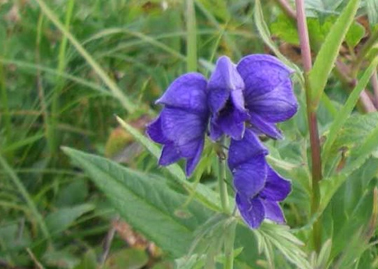
Aconitum delphinifolium, Monkshood, growing on Kodiak Island, Alaska.
Photo: The Saltonstalls
Permalink
Orthodox Epitaphio
Easter in the Orthodox Church is celebrated April 15, 2012, one week after the Western denominations. Unlike the Roman Catholic Church and Protestant Christian sects, Orthodox custom celebrates even Good Friday with flowers. An epitaphio, a small replica of Christ’s tomb, is made of flowers, and inside the Bible or religious icons are presented for believers to adore.
Here’s a slideshow of Orthodox Easter rites across Europe and the Middle East. And here’s an article about the epitaphio custom in Pittsburgh, Pennsylvania.

An Orthodox worshipper in Thessaloniki, Greece, enters the epitaphipo touches her head on the Bible which has been decorated with flower petals on Good Friday, April 13, 2012
Photo: Nikolas Giakoumidis, for AP
